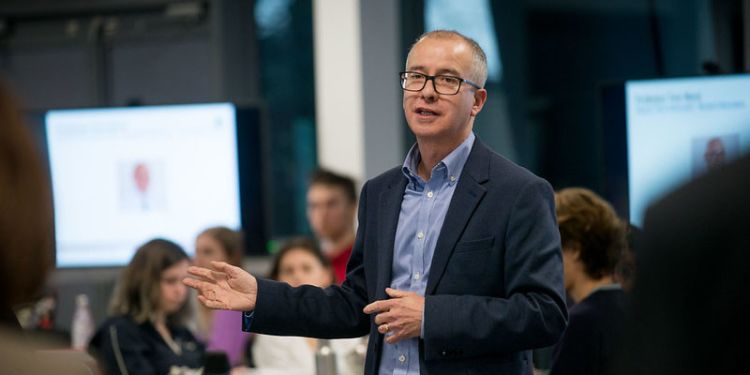Top tips for innovating in the digital world

In this article, Associate Professor Tony Morgan shares his views on how organisations can use ‘Design Thinking’ approaches to innovate in a more digital and remote-working world.
Tony Morgan is an Associate Professor in Innovation Management. He joined Leeds University Business School in 2019 following a successful career in technology and innovation at IBM.
What is Design Thinking?
At its core, Design Thinking is a process for creative problem solving. It encompasses a range of very practical techniques for developing more innovative products, services and other solutions. For me, Design Thinking focuses on two key elements.
Firstly, it’s human-centric. We need to create, design and improve products, services and processes by using empathy and an understanding of the real needs of the people who will be using them.
Secondly, we need to fall head over heels in love with the problems we’re trying to solve, before we start making proposals about solutions. Design Thinking requires us to research and understand the challenges we’re looking to address – before we jump into creating solutions to address them. When we don’t do this, all too often the solutions we create simply aren’t fit for purpose.
I’m sure we can all think of examples of mobile apps and websites and even physical spaces (such as public toilet exits which you have to touch three times after you’ve washed your hands), which haven’t been designed with real people and real-world problems in mind.
Diversity, divergence and convergence
The Design Thinking process takes us through a series of iterative steps to achieve better outcomes. To do this, it encourages the use of some hugely effective concepts along the way.
The first is diversity. If you put ten similar people from similar backgrounds together, what sort of ideas do you think come up with? Similar ones, most probably. More often than not, the best ideas come from diverse teams. Of course, diversity comes in many forms – from the more obvious ones, such as gender, age and nationality, to other areas, such as knowledge specialisms, cultural background and levels of experience.
My favourite (and I think the best) innovation projects at IBM were the ones where we mixed up the wise-old technology heads with unconstrained thinking from new graduates, placement students and apprentices, along with the business and industry acumen of our clients. These always delivered better results than any of the three groups could have achieved alone.
Then there’s divergence and convergence. Many Design Thinking techniques are structured to use multiple steps. Some of these force us to diverge to get the unique input from every individual. In others, we’re encouraged to converge to leverage the collective power of the team.
The business expert suggests this, the technology specialist says that, and the new graduate adds a third perspective. Before you know it, the more diverse team has created a train of thought that’s totally new, and almost unstoppable.
One thing you need for all of the above though is excellent facilitation.
Physical and digital workshops and design spaces
I’ve facilitated many workshops over the years, taught students and trained companies in physical rooms. In these, we use tables, walls and flip charts for workspaces. It’s possible to read participants’ body language, engagement and energy levels. There are often great results, but what about working online?
Over the last year in particular, I’ve spent a lot more time working online, and the good news is you can achieve as much, and sometimes even more, than in a physical room. To do this, you need people, process and technology. There’s some good news! The people and process (i.e., Design Thinking and other innovation techniques) are the same for both. The main thing that’s different is the technology.
We can combine a video conferencing tool (such as Zoom or Teams) with an online workshop and collaboration platform (such as Mural or Miro) to great effect. It’s possible to use these to mimic, and sometimes improve upon, what we do in a physical space by using breakout rooms, virtual flip charts and sticky notes.
Preparation is definitely the key to success. I send out a quick but meaningful practice exercise for the platform beforehand, so we’re focusing on the problem in the workshop, rather than teaching the tech. Other things to consider include planning for ways to gain, maintain and measure engagement and having plenty of short breaks to limit ‘Zoom-fatigue’.
One of the great benefits of online working is the increased potential for diversity of participants. For example, along with my colleague Dr Lena Jaspersen, we recently ran an online workshop with the United Nations Environment Programme. The attendees were much more diverse than if they (and we) had had to travel to a location. And, of course, with no travel, there are major sustainability and personal time benefits too.
Building your solution
Prototyping is another key Design Thinking activity, I’m a great believer in building quick mock-ups and prototypes in the early stages of innovation and using these to communicate and demonstrate our ideas. If people like them, that’s great, we can move onto building a real capability. If not, think how much time, money and effort we’ve saved.
Getting a prototype right is important. We can then use it to communicate how we’re really going to solve the end users’ problems and the value we’re going to create for the organisation. After all, we can have the best idea in the world, but if we can’t communicate the idea and the value, it won’t go anywhere.
Further reading
If you’ve found this article interesting and want to find out more about Design Thinking, I’d recommend the IBM and IDEO Design Thinking websites as a good place to start, or get in touch with me directly on LinkedIn.




